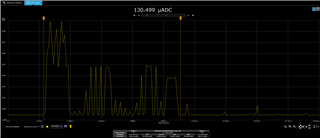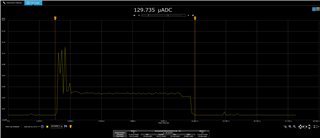In our use case we are using the nRF9160 in eDRX mode with an eDRX interval of 40.96sec.
I'm noticing that the power required to transmit a message varies widely between AT&T and Verizon. Both networks require about 9 seconds to transmit the message and return to sleep.
On Verizon after the initial transmit, the nRF9160 remains at a fairly constant ~45mA for the reminder of the time.
On AT&T after the initial transmit, the nRF9160 current varies between ~100uA and ~45mA. It appears that the timing is about 280ms sleep, then 80ms on which repeats for the reminder of the 9seconds.
The average power on AT&T is therefore much lower and being a battery powered device this is important.
Attached are two screen captures of the current into the device when sending a packet. Note that the sample speed of this capture is not fast enough to fully capture all points, but you can clearly see the difference I'm talking about.


Is this expected behavior?
Are there settings available to adjust this behavior?
We are looking to send messages at the lowest possible power.


